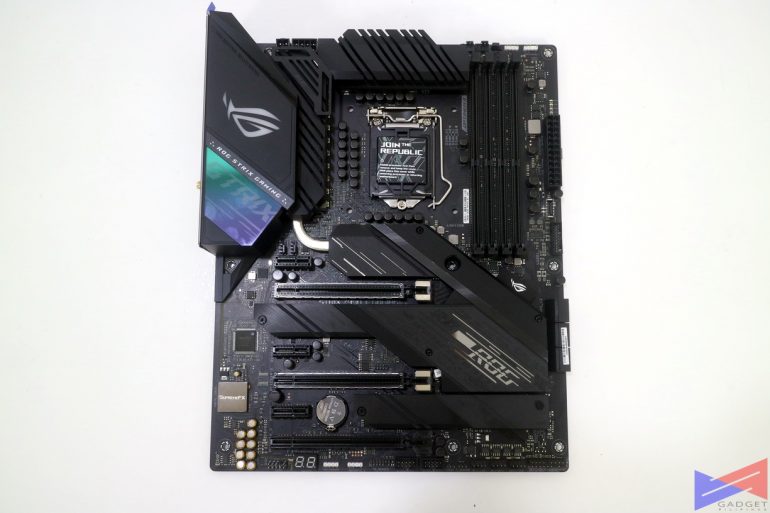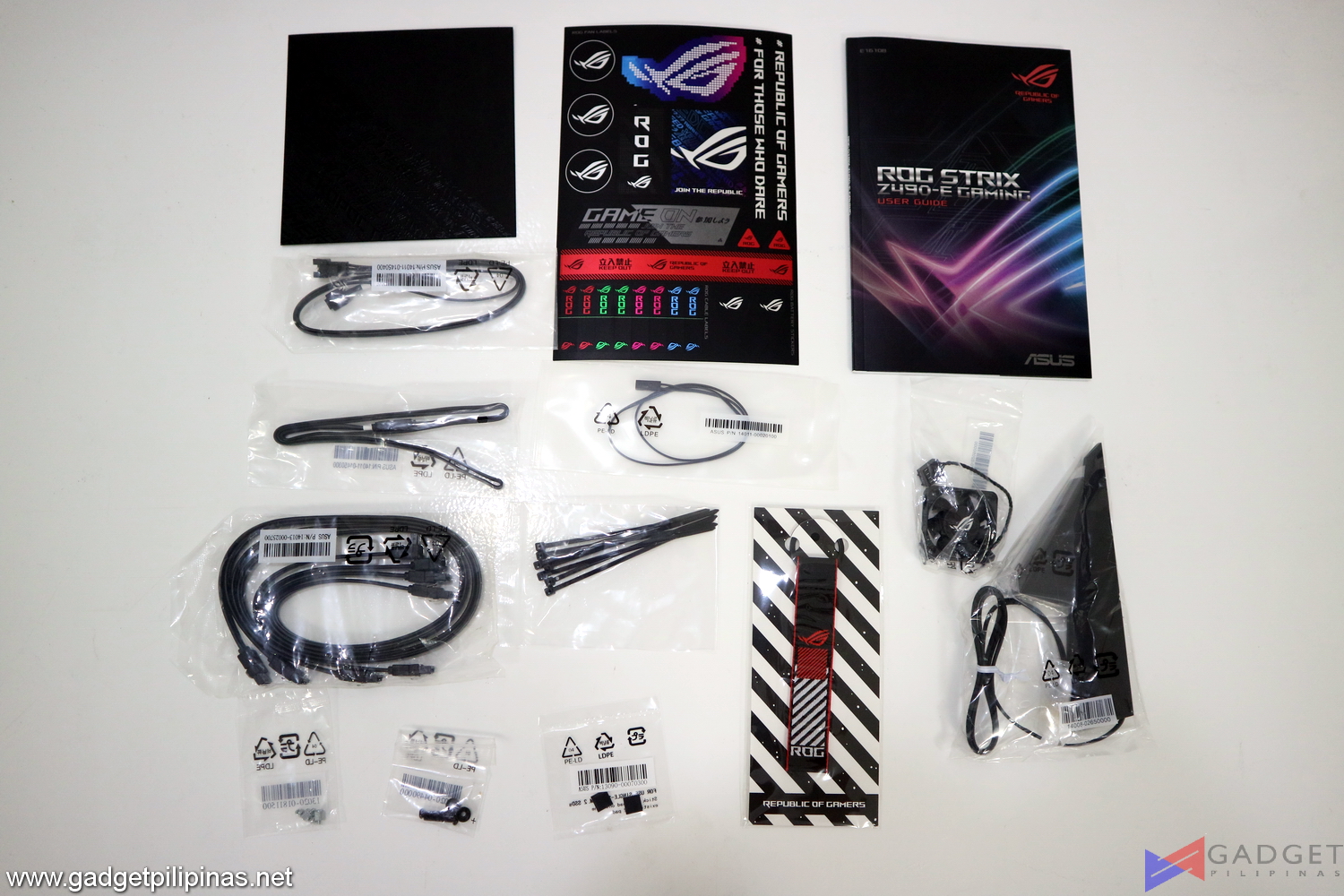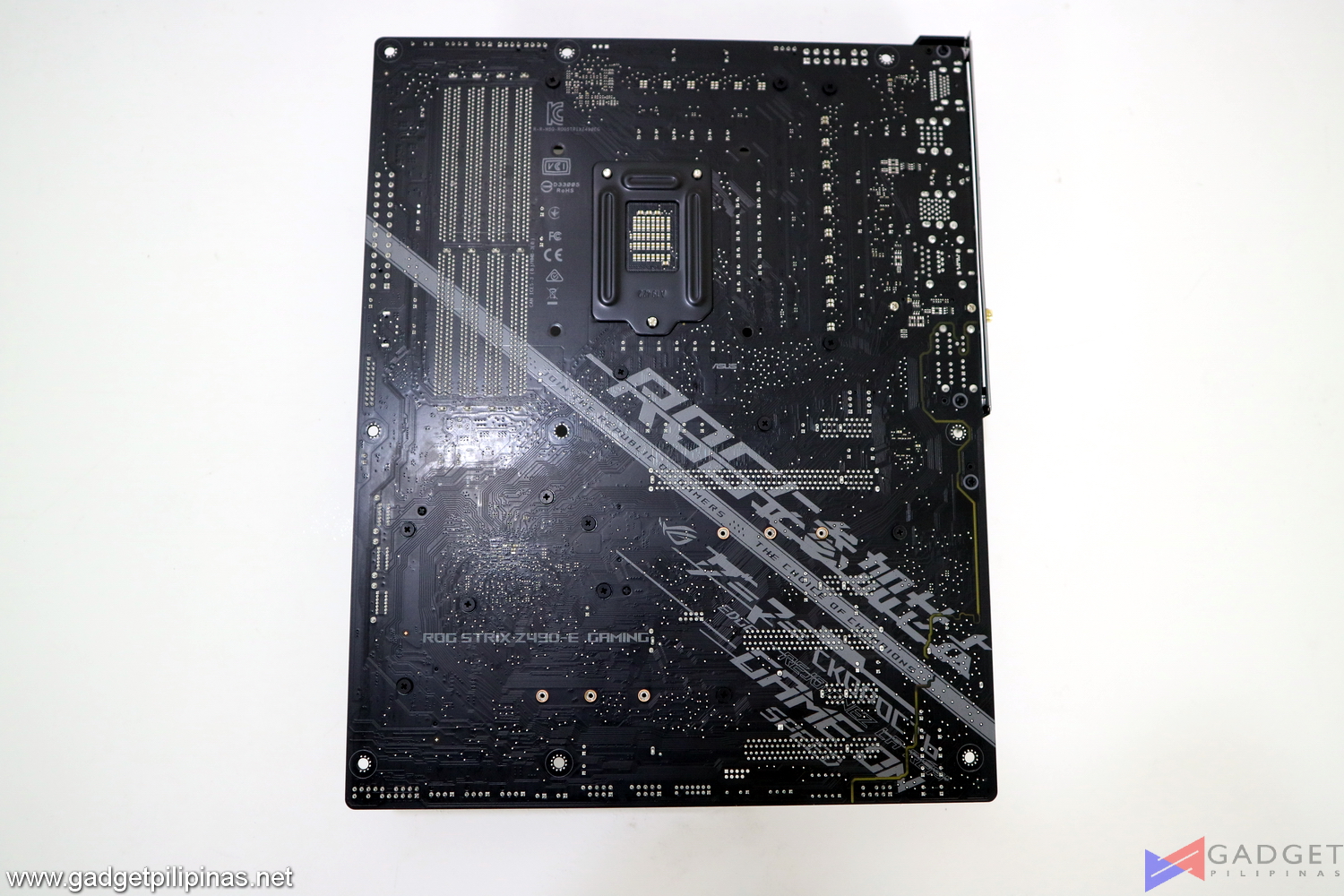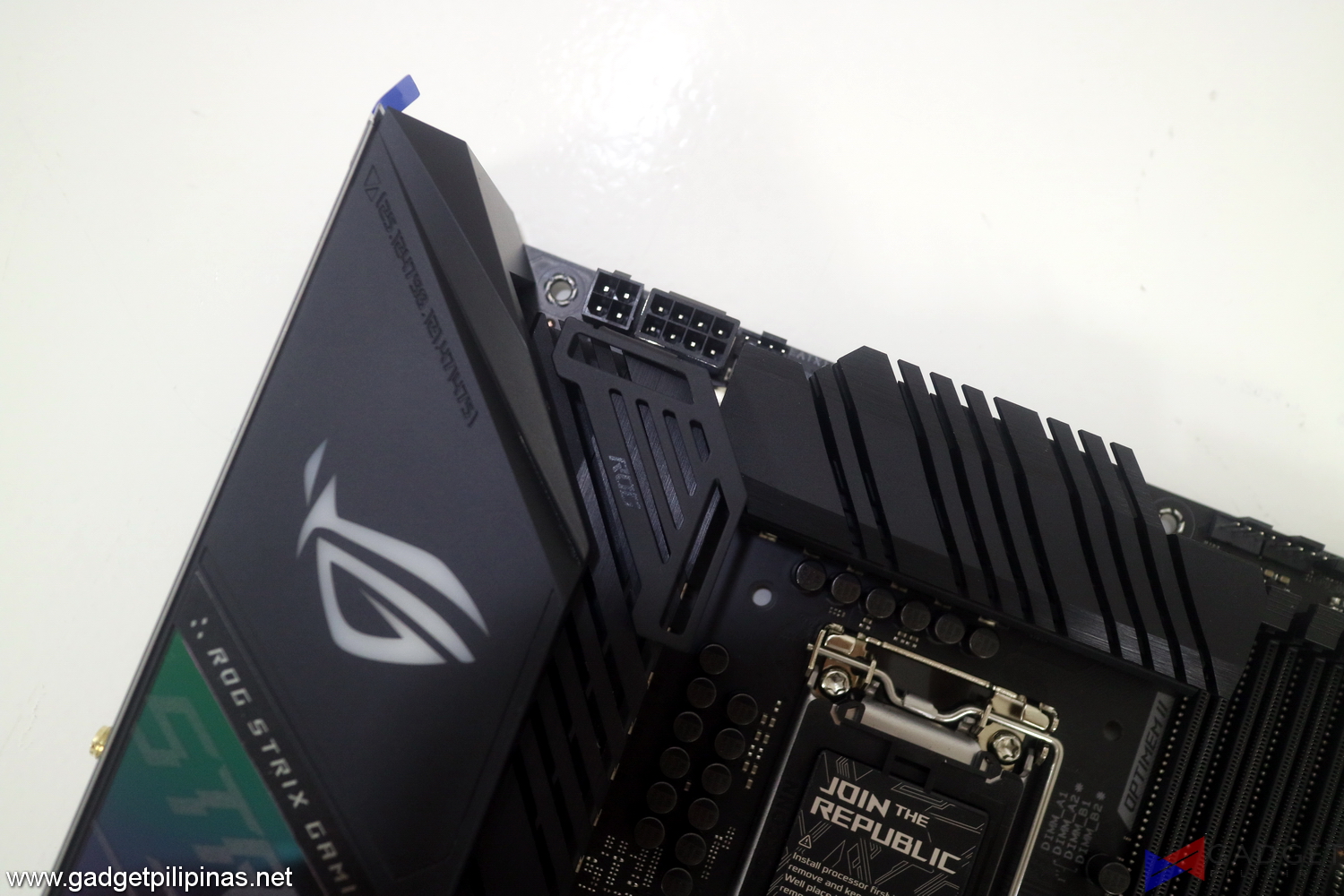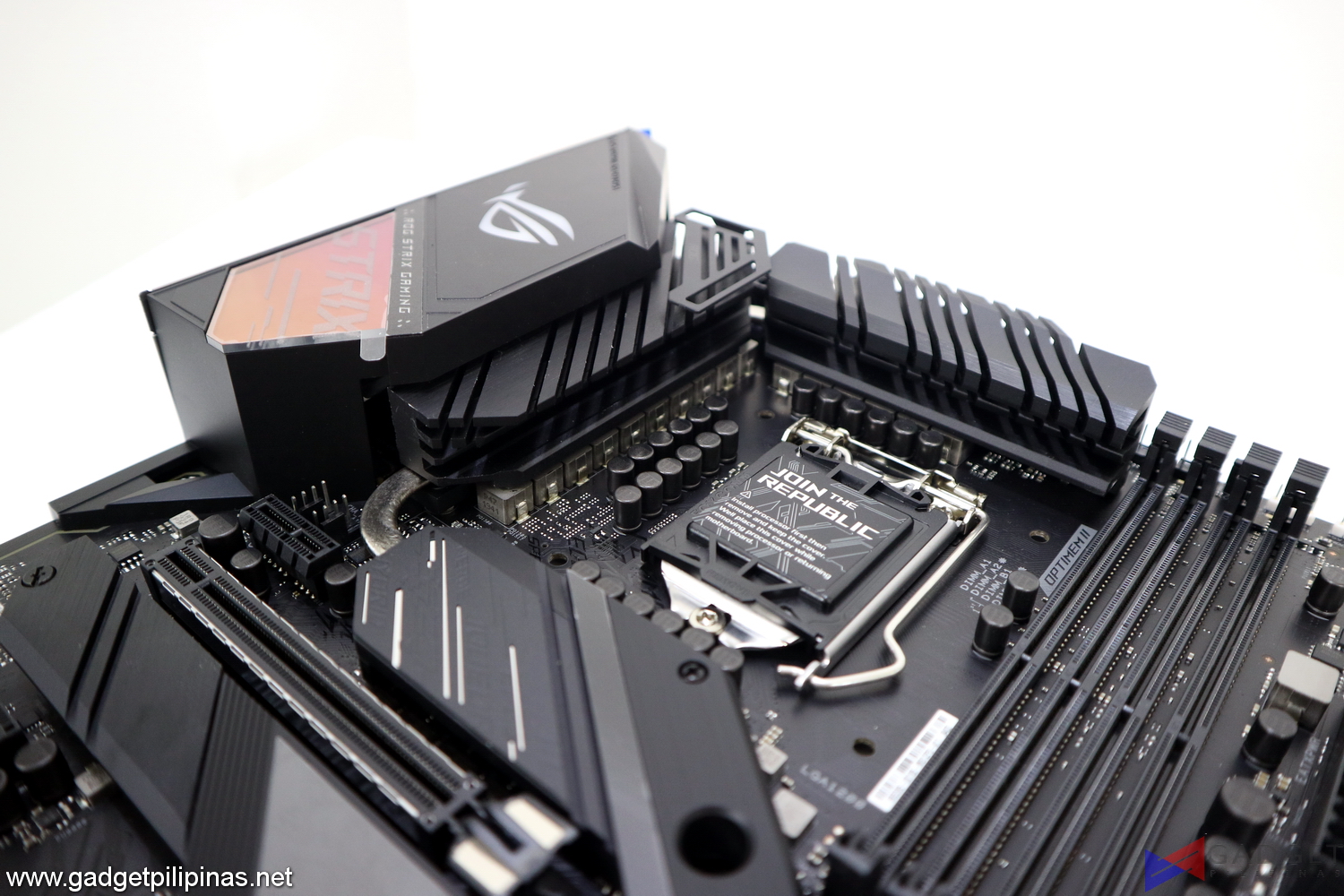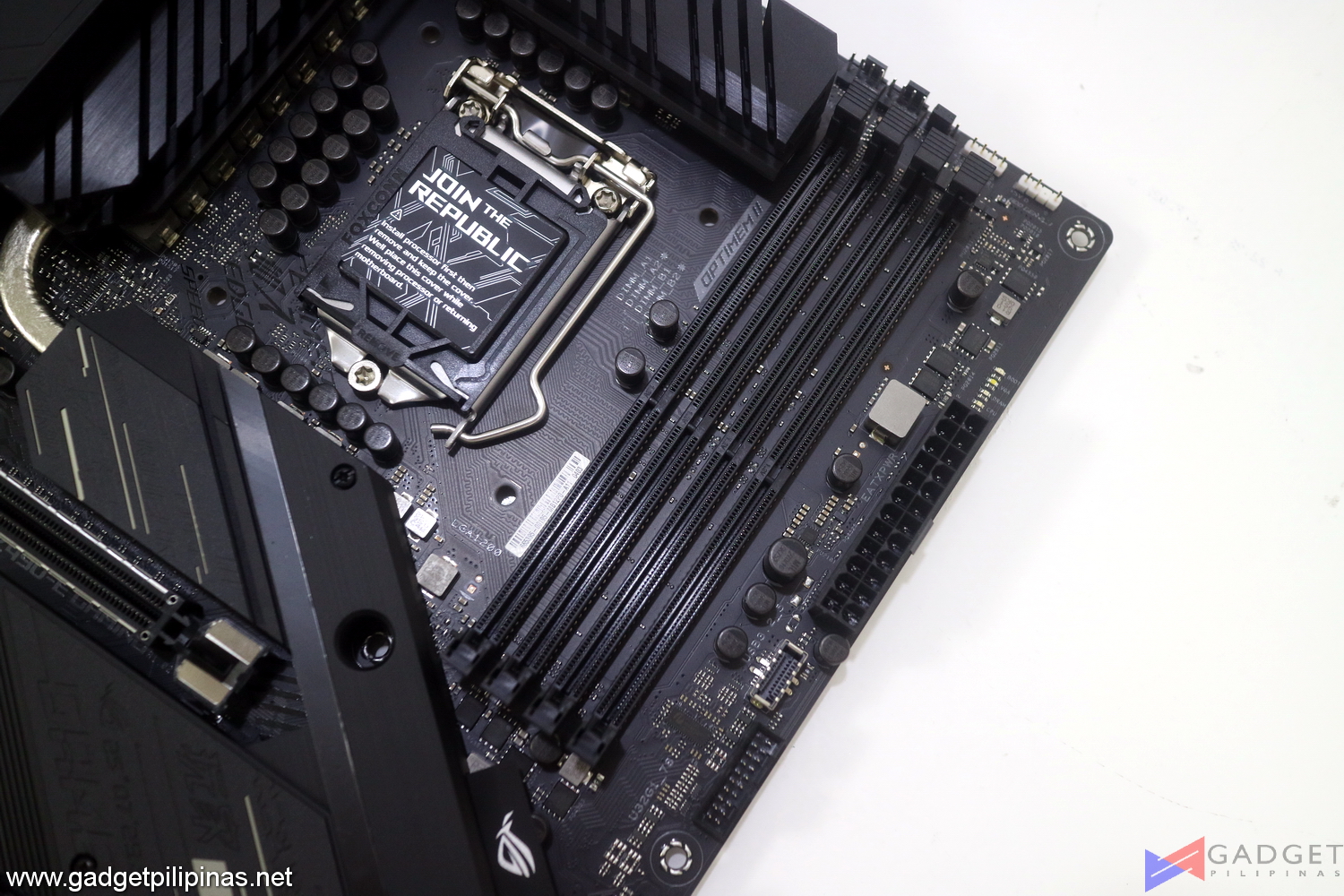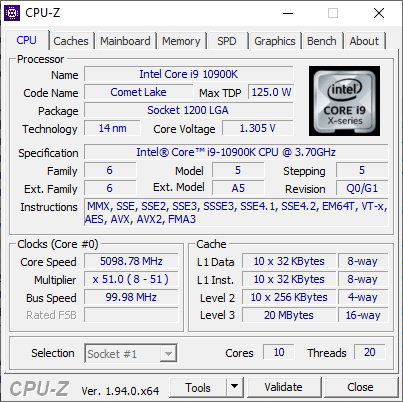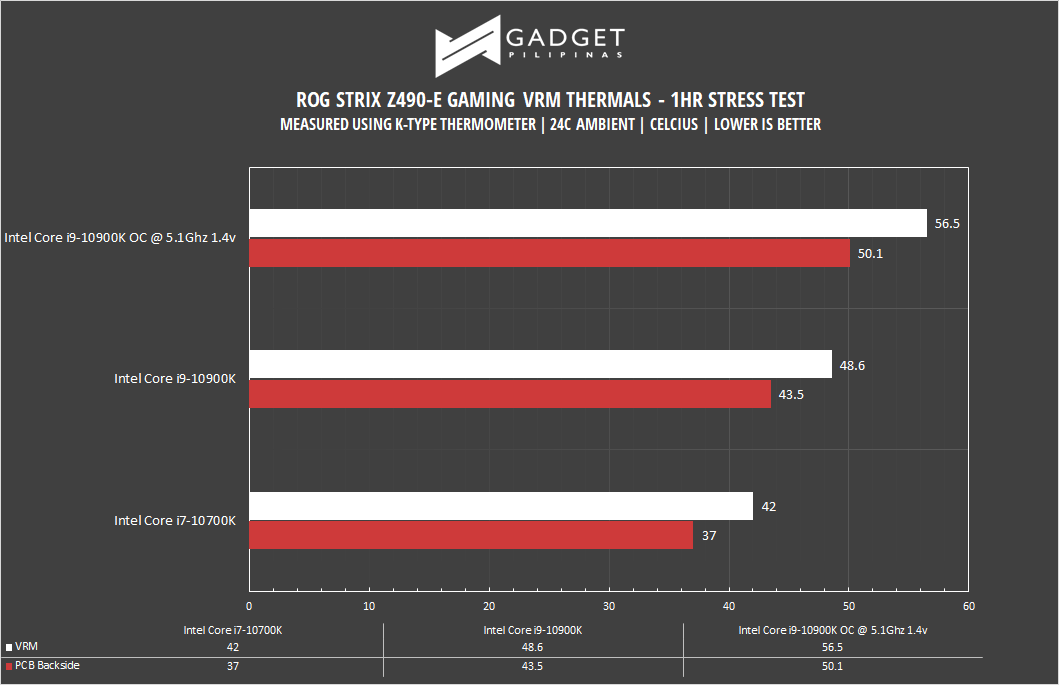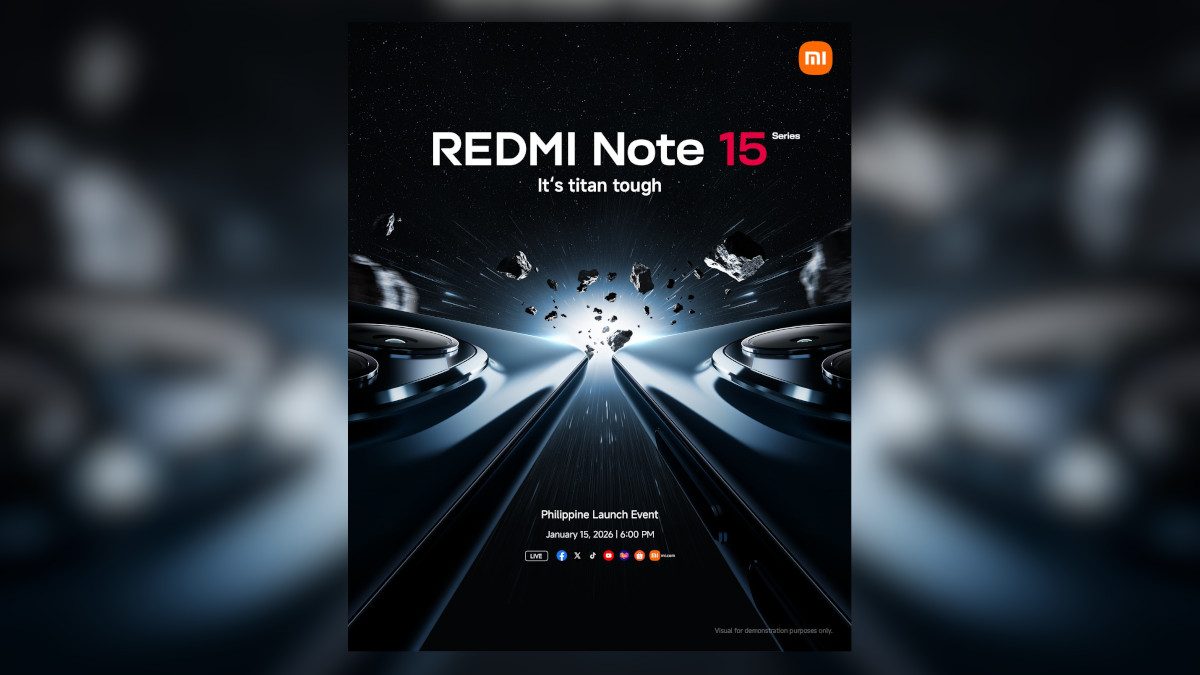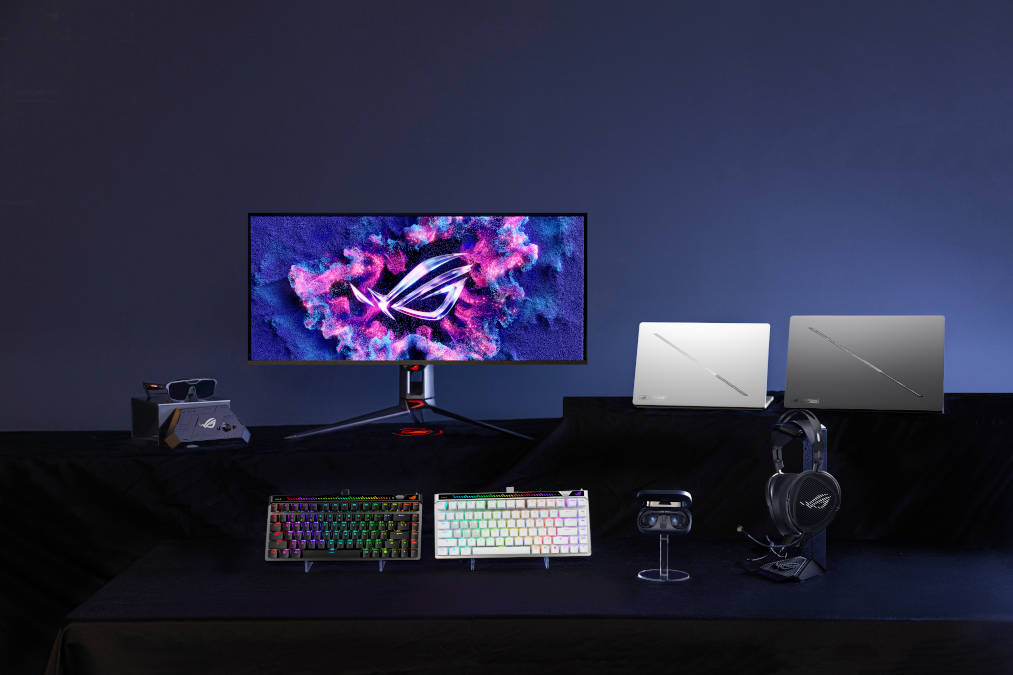INTRODUCTION
ASUS’ ROG Strix Motherboards are pretty much-established products, especially in the enthusiast space. It’s not just about the ROG Strix Tax, but because Asus undeniably offers one of the best motherboard tiering and differentiation. We’ve been using the ROG Strix X570-E for our AMD Ryzen 7 3700X benchmark and as we switch to Intel, we opted for the ROG Strix Z490-E Gaming motherboard, the same ROG Strix E-tiered motherboard albeit in Intel colors.
Intel’s 10th generation processors are one of the most awaited releases for 2020 as it is supposed to be the company’s response towards AMD’s Ryzen 3000 and 4000 series based on the Zen 2 Architecture under the 7-nanometer process. The launch of the new 10th generation processors marks that Intel doesn’t want to easily give up its gaming crown as the brand also targets AMD’s position in productivity by adding more cores to its mainstream desktop lineup. While many consumers are upset about Intel’s 10th-gen processors still being produced under the 14nm lithography, Intel surely did invest in R&D to refine the 14nm process for their CPUs to keep up with the competition. PC Enthusiasts are riled up as the market gets competitive again which means better pricing and more options for consumers.
The Intel 10th-gen Comet Lake processors use the LGA 1200 socket, thus requiring a new generation of motherboards. The first wave of motherboards supporting the LGA 1200 socket uses Intel’s Z490 chipset, which is the successor of the Z390 chipset. Let’s discuss what’s new with the Z490 chipset in the form of the ASUS ROG Strix Z490-E Gaming motherboard as well as ASUS’ own improvements to make this motherboard a decent pair for your Intel 10th Gen CPU.
Asus ROG Strix Z490-E Gaming Specifications
| Socket | LGA 1200 |
|---|---|
| Chipset | Z490 |
| Form Factor | ATX |
| Voltage Regulator | 16 Phase (14+2) 50A, Teamed |
| Video Ports | (1) HDMI (v1.4b),(1) DisplayPort (1.4) |
| USB Ports | (1) USB 3.2 Gen 2, Type-C (10 Gbps), (3) USB 3.2 Gen 2, Type-A (10 Gbps), (2) USB 3.2 Gen 1, Type-A (5 Gbps), (4) USB 2.0, Type-A |
| Network Jacks | (1) 2.5 GbE |
| Audio Jacks | (5) Analog + SPDIF |
| Legacy Ports/Jacks | ✗ |
| Other Ports/Jack | Wi-Fi Antenna |
| PCIe x16 | (3) v3.0 (x16/x0/x4 or x8/x8/x4) |
| PCIe x8 | ✗ |
| PCIe x4 | ✗ |
| PCIe x1 | (2) v3.0 (x1) |
| CrossFire/SLI | AMD 3/2 Way CrossFireX and Nvidia 2-Way SLI |
| DIMM slots | (4) DDR4 – DDR4 4600(OC) |
| M.2 slots | (1) PCIe 3.0 x4 / SATA + PCIe (up to 110mm), (1) PCIe 3.0 x4 PCIe only (up to 110mm) |
| U.2 Ports | ✗ |
| SATA Ports | (6) SATA3 6 Gbps |
| USB Headers | (1) USB v3.2 Gen 2 (Type-C), (1) USB 3.2 Gen1, (1) USB v2.0 |
| Fan/Pump Headers | (7) 4-Pin |
| RGB Headers | (2) Aura Addressable RGB (3-pin), (2) Aura RGB (4-pin) |
| Legacy Interfaces | ✗ |
| Other Interfaces | FP-Audio, TPM |
| Diagnostics Panel | Yes |
| Internal Button/Switch | ✗ |
| SATA Controllers | ✗ |
| Ethernet Controllers | (1) Intel I225-V (2.5 GbE) |
| Wi-Fi / Bluetooth | Intel AX201 (802.11ax, MU-MIMO, 160 MHz) / BT 5.1 |
| USB Controllers | ✗ |
| HD Audio Codec | SupremeFX S1220A |
| DDL/DTS Connect | ✗/ DTS Sound Unbound |
| Warranty | 3 Years |
ASUS ROG Strix Z490-E Unboxing and Overview
- ROG Strix Z490 E Gaming Motherboard Review 009
- ROG Strix Z490 E Gaming Motherboard Review 009
- ROG Strix Z490 E Gaming Motherboard Review 004
- ROG Strix Z490 E Gaming Motherboard Review 004
The ROG Strix Z490-E Gaming is wrapped in typical ROG Strix fashion with the RGB Strix logo on the left side. This time around, the box is in landscape orientation that reveals the motherboard in a portrait format. The backside highlights the specs and features of the motherboard. Asus has done a good job maximizing the visuals and description on the box side of the motherboard.
- User’s manual
- 1 x ASUS Fan Holder
- 4 x SATA 6Gb/s cables
- 1 x Supporting DVD
- 1 x MOS Cooling kit (fan bracket and 40mm x 40mm fan)
- x ROG Strix stickers
- 1 x Cable ties pack
- 1 x Extension Cable for RGB strips (80 cm)
- 1 x Extension cable for Addressable LED
- 1 x Thermistor cable
- 1 x ROG Thank you card
- 1 x 2-in-1 Rubber pad
- 1 x Wi-Fi moving antenna
- 1 M.2 SSD screw package
- 1 ROG key chain

Design-wise, the ROG Strix Z490-E Gaming maintains the signature cyberpunk dystopian theme. The main visual improvement over the previous generation is the markings near the VRM IO shield and the Z490 chipset. It’s a cleaner design that gives a more premium appeal to the motherboard.
ASUS went the extra mile in designing the back of the PCB with its signature ROG cybertext. All Asus Z490 motherboards have six PCB layers with 2oz copper. Having this much thickness makes the motherboards sturdy aside from the beefy VRM heatsinks that greatly contribute to its weight.
ASUS enforced all of its power connectors with solid-core pins to ensure secure contact with PSU cables. It also prevents hotspots by providing efficient heat dissipation increasing its overall reliability.
ASUS uses teamed power architecture for all of its ROG motherboards instead of using the conventional doubler VRM setup. A doubler halves the power that enters the VRM for a lighter load but sacrifices in voltage quality caused by the higher transient response. A themed power architecture, on the other hand, doesn’t half the power for better CPU stability during heavy workloads or overclocking.
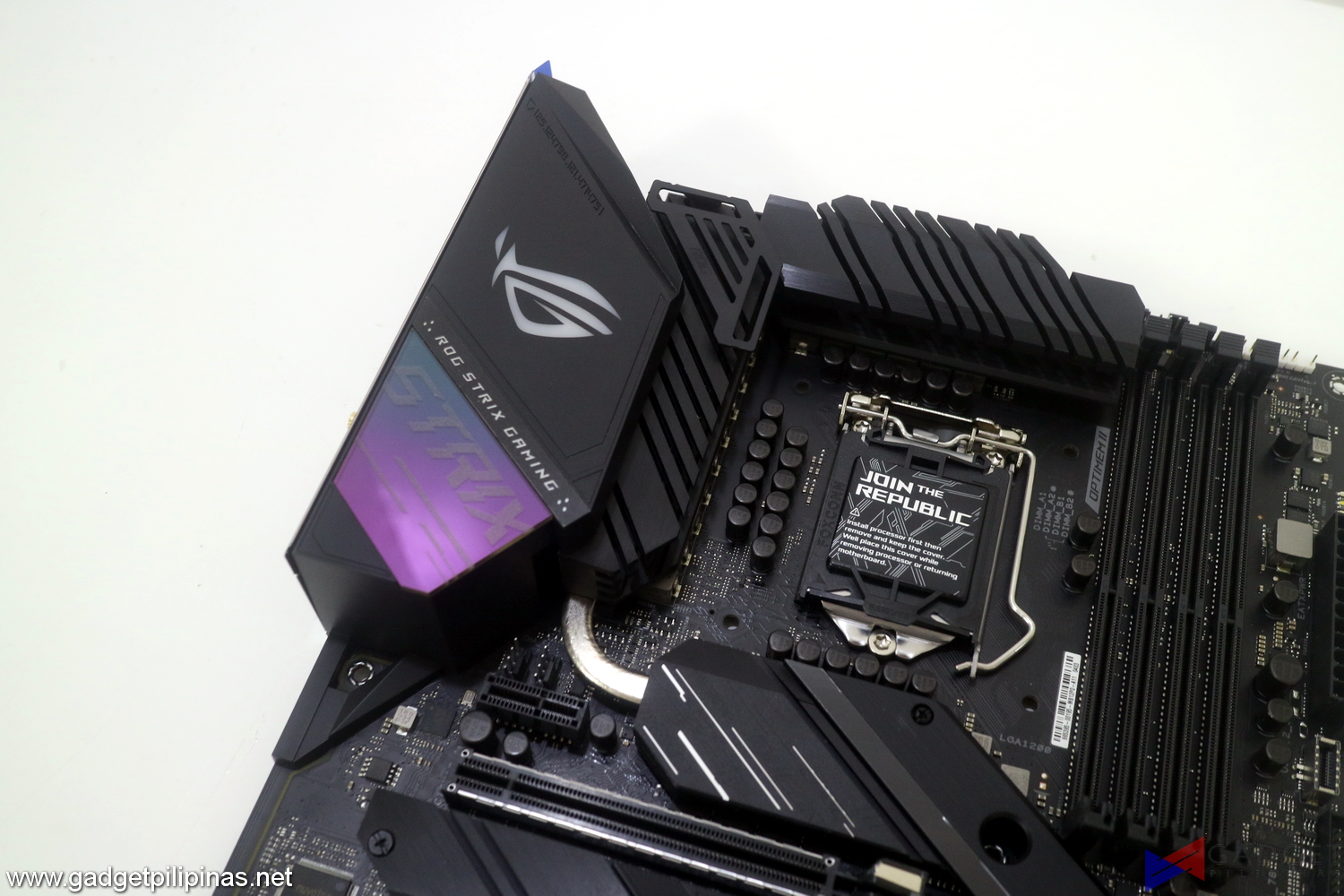
Being a Strix-E board, the ROG Z490-E Strix uses a 14+2 power stage design delivering power, 2 more power stages compared to the rest of the Strix product stack. Vishay SIC654 power stages run in parallel aka in teamed configuration for efficient power-handling without the need of doublers. The “U” shaped or “C” shaped heatsink and copper setup reminisce us of the northbridge and southbridge days of Intel’s 4th gen CPUs. The Extended MOS and VRM heatsink provide faster heat transfer for better performance and wattage resistance.
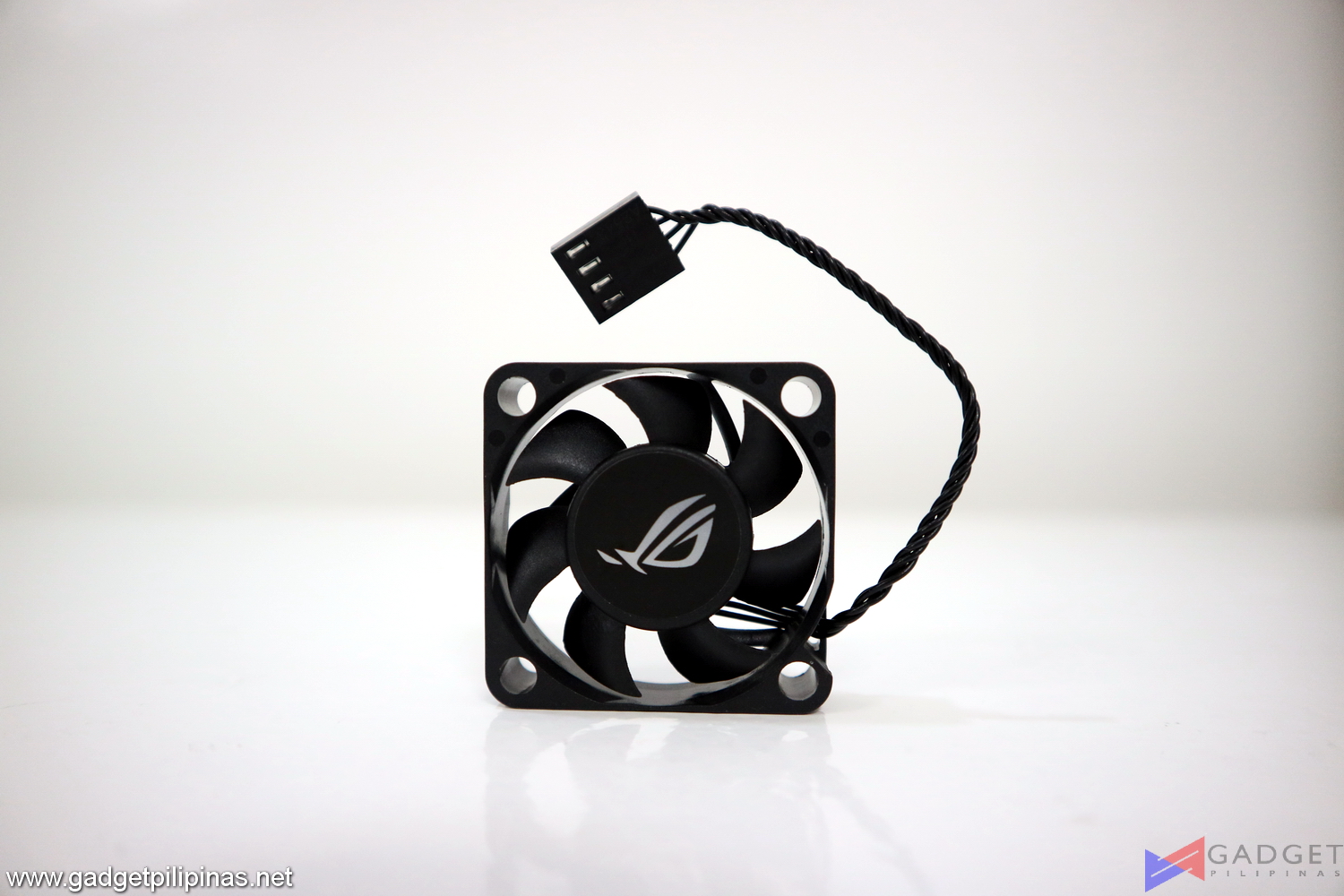
ASUS ROG included a MOS fan and bracket giving the user an option to mount it on the VRM and cool it actively. The MOS fan has a standard 40mm size and can be swapped out for aftermarket solutions.
Z490 motherboards support DDR4-2933 memory out of the box but the Strix Z490-E supports up to 4,800Mhz OC. Support for high-frequency memory is possible thanks to Optimem II and ASUS using Daisy Chain trace design instead of T-Topology. A Daisy Chain trace design is able to achieve a higher peak frequency by reducing signal and reflection as it enhances compatibility, performance, and the overclocking margin of one DIMM per margin.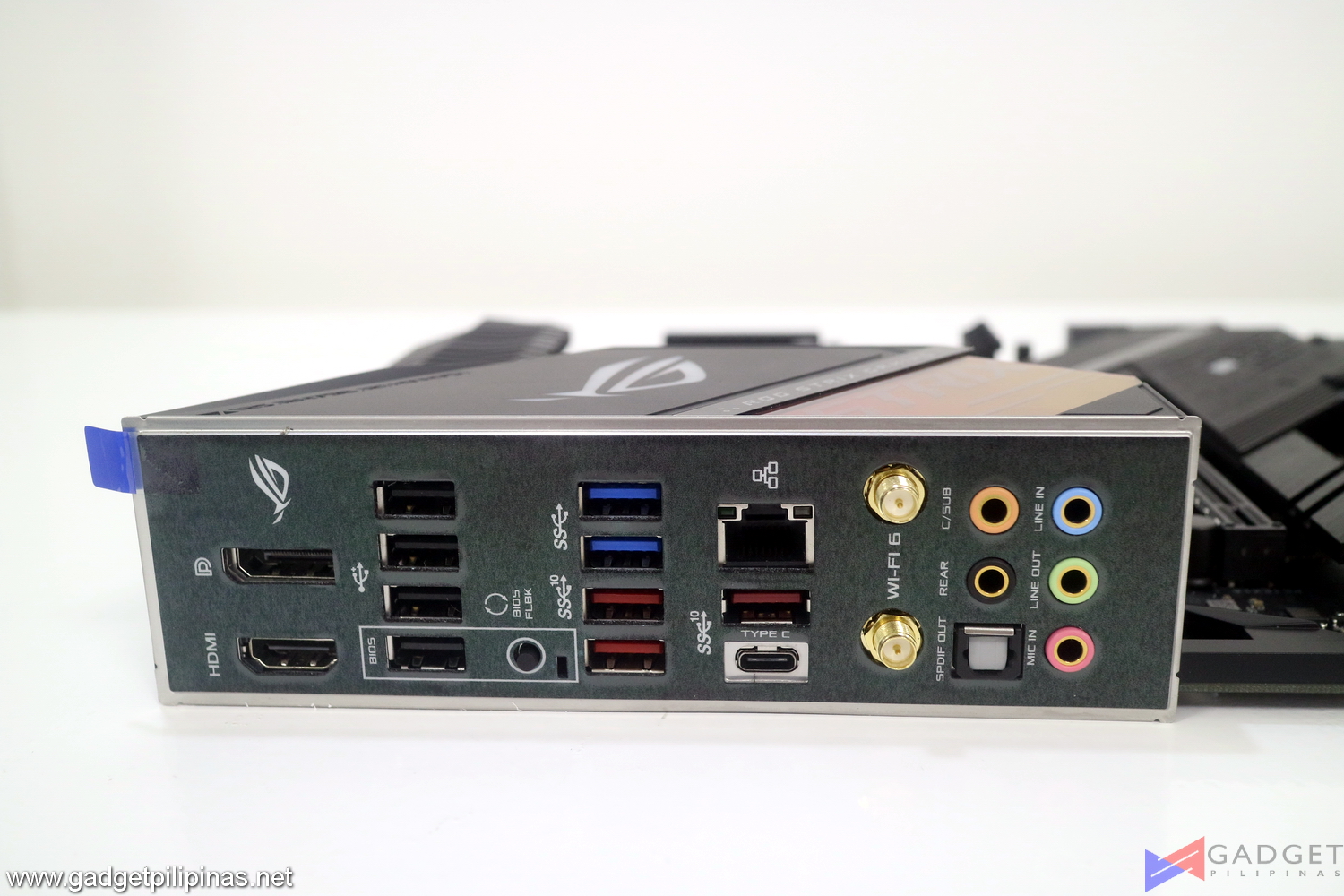
Intel’s Z490 chipset supports a robust amount of USB ports with more bandwidth compared to both Z390 and Z370. There are four USB 3.2 Gen 2 ports with 10Gbps bandwidth, one of which is a Type-C port. Two USB 3.2 Gen 1 ports are also included with four more USB 2.0 ports. One USB 2.0 port is dedicated for BIOS update which is located beside the very convenient BIOS FlashBack button. Apart from the standard video outputs and gold plated audio jacks, there’s also a Wi-Fi module for the built-in Intel Wi-Fi 6 AX201 receiver. You can click this text to watch our WiFi-6 discussion video.
It’s nice to see ASUS ROG permanently sticking to pre-mounted I/O shields.
- ASUS ROG Strix Z490 E Gaming Motherboard Review 128
- ASUS ROG Strix Z490 E Gaming Motherboard Review 128
- ASUS ROG Strix Z490 E Gaming Motherboard Review 060
- ASUS ROG Strix Z490 E Gaming Motherboard Review 060
The ROG Strix Z490-E Gaming Motherboard offers three PCIE Gen3 x16 slots with the first two slots reinforced by steel and supports Nvidia SLI and AMD Crossfire multi-GPU technology. There are also three PCIE Gen3 x1 slots.
As for internal storage, the ROG Strix motherboard supports six SATA 6Gb/s ports that are angled at 90degress for easier connectivity. Additionally, it has two M.2 slots that both support PCIE 3.0 x4 SSDs. The first M.2 slot supports SATA based M.2 SSDs as well. The first M.2 slot is no longer positioned before the first PCIE Gen3 x16 slot and is now after the x16 slot. Its placement can cause a thermal issue as the SSD will be blocked physically regardless of what GPU you will install.
- ASUS ROG Strix Z490 E Gaming Motherboard Review 063
- ASUS ROG Strix Z490 E Gaming Motherboard Review 063
- ASUS ROG Strix Z490 E Gaming Motherboard Review 146
- ASUS ROG Strix Z490 E Gaming Motherboard Review 146
Accessing the first M.2 slot is very troublesome as the user is required to remove the Z490 chipset shroud first to access the necessary M.2 screw. Not to mention the hassle of removing the GPU to physically access the SSD plugged into the first slot for troubleshooting. Both M.2 slots’ covers act as a heatsink for your M.2 SSDs. This problem is not new on the ASUS Strix Z490-E Gaming, we hope this problem will be addressed on future motherboard releases.
AI Features

Software improvements also come alongside the hardware tweaks we’ve seen so far. These improvements make the ASUS ROG Strix Z490-E Gaming Motherboard an “intelligent motherboard” thanks to AI-driven features. These features are available across the ROG Strix Z490 motherboard line.
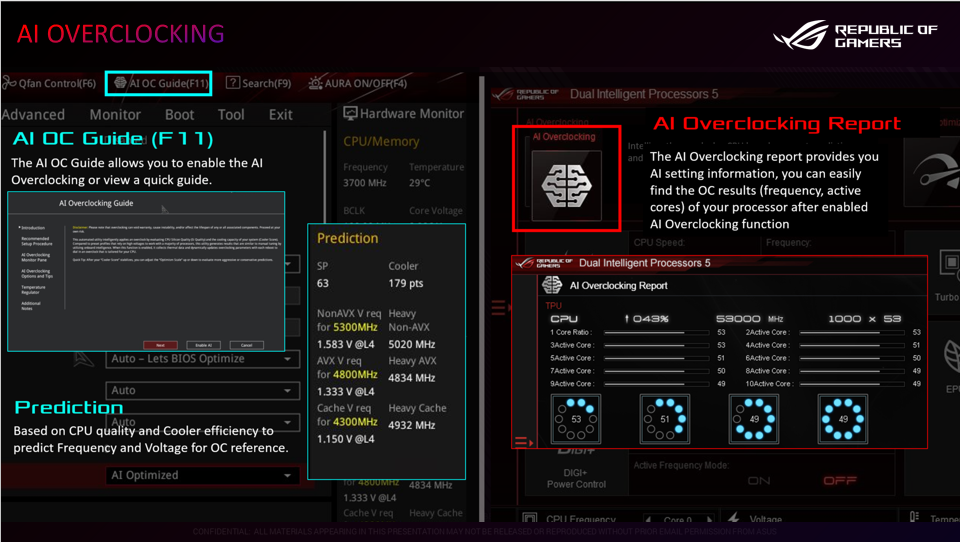
Asus has improved the motherboard’s AI overclocking capability by being able to recognize CPU potential and cooling capacity to predict the best overclocking setting. Gone are the days of AI software applying too much voltage with only a small incremental bump in clock speed.
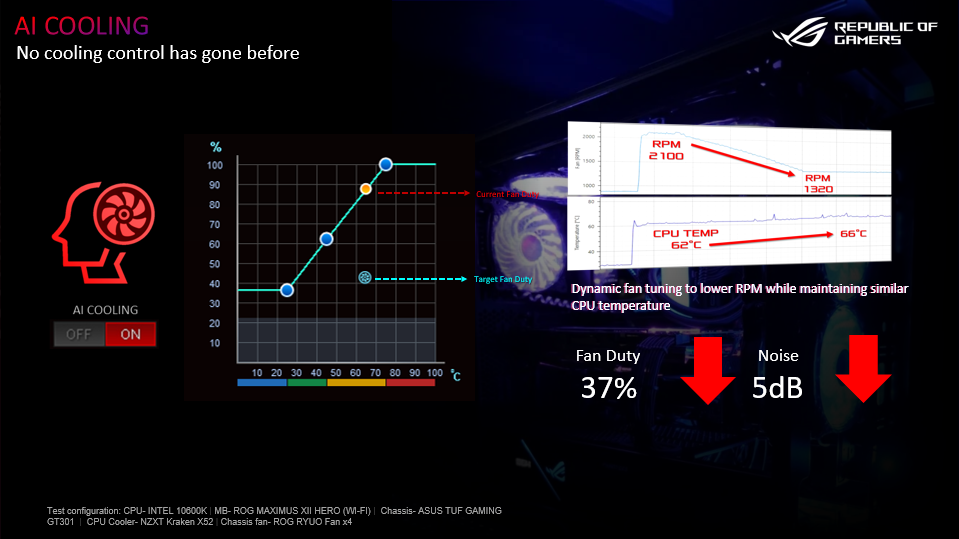
ASUS also tweaked its Asus fan control feature by reducing its aggressiveness in applying a certain fan speed levels to maintain a good balance of fan noise and temperatures. The AI software is now able to decrease fan speed sacrificing only around 2-5degrees celsius but gaining a more acceptable noise level and fan workload.
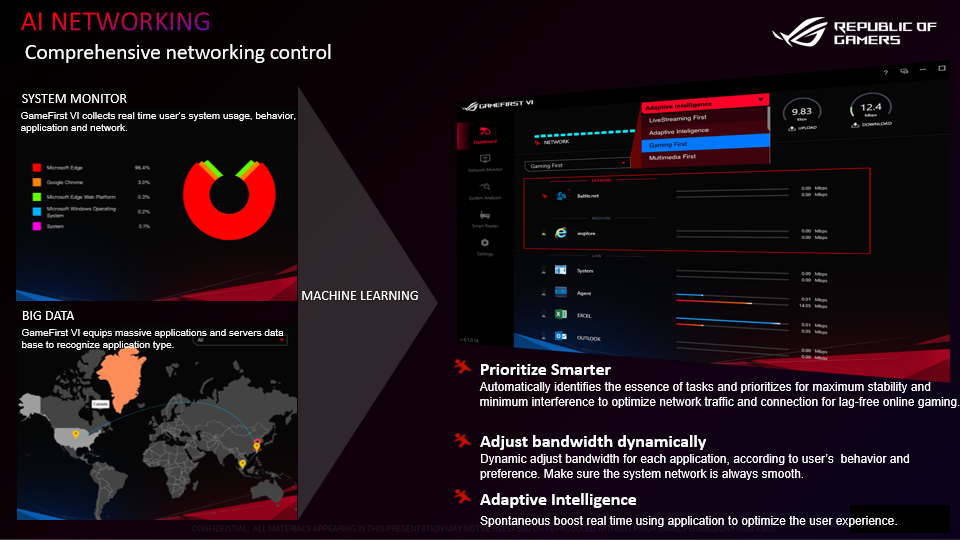
GameFirst VI now includes AI-driven features as well. The previous GameFirst V software allocates bandwidth equally regardless of the type of video you’re watching whereas GF VI will automatically allocate more bandwidth to movies and lesser bandwidth to news and short videos.
Benchmark Setup and Methodology
Gadget Pilipinas’ testing philosophy is to provide detail-oriented results as accurately as possible that our readers can replicate our tests given that these conditions are met. Different benchmarking apps and sequences are used depending on the component or device being tested.
| ASUS ROG Strix Z490-E Gaming Motherboard Review Test Bench Specs | |||
| Motherboard | ASUS ROG Strix Z490-E Gaming | ||
| COOLER | Corsair H100i RGB Pro XT 240mm AIO | ||
| CPU | Intel Core i9 10900K | Intel Core i7 10700K | |
| MEMORY | TForce XTREEM 16GB(8GBx2) 3200Mhz | ||
| GPU | Inno3D RTX 3070 iChill X4 | ||
| STORAGE | TForce CARDEA Liquid NVMe SSD | ||
| POWERSUPPLY | ThermalTake ToughPower 1200w Platinum | ||
| OPERATING SYSTEM | Windows 10 Pro Build 2404 | ||
| DISPLAY | Lenovo Legion Y27Q Gaming Monitor | ||
We use CapFrameX as our FPS capture and analysis tool for all our gaming benchmarks. The latest build version of Windows 10 and WHQL certified drivers are used for our benchmarks. Readings such as temperatures and power draw are recorded using HWMonitor and HWInfo64 as well as other relevant software used for cross-checking. We use a TASI 8620 k-type thermometer to record our VRM temperature readings.
- Cinebench R20
- V-Ray
- HWBot x265
- Handbrake
- Blender
- Corona Renderer
- Super PI – 32M Calculations
- wPrime – 1024M Calculations
- AIDA64 Extreme Edition – Memory Benchmarks
- PCMark10 Extended
- 3DMark Firestrike
- 3DMark TimeSpy
For this review, we tested the ASUS ROG Strix Z490-E Gaming motherboard using both the Intel Core i7 10700k as well as the Intel Core i9 10900k to measure how the motherboard treats a 125w TDP processors as well as the “unlocked” 250w TDP of the i9 10900k.
ASUS ROG Strix Z490-E Gaming Benchmarks
SuperPI 32M
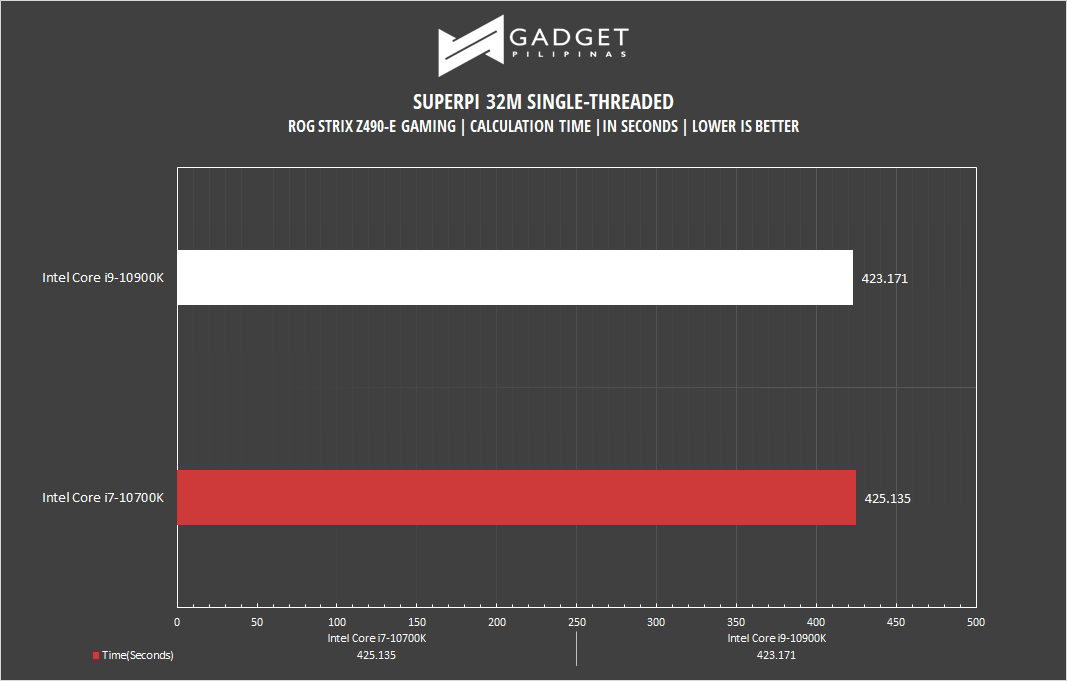 SuperPI is a single-threaded benchmark application that lets the CPU calculate Pi(π) to the nth digit. In this benchmark, we selected the Pi calculation to 32M, the highest available for the app.
SuperPI is a single-threaded benchmark application that lets the CPU calculate Pi(π) to the nth digit. In this benchmark, we selected the Pi calculation to 32M, the highest available for the app.
wPrime 1024M
 wPrime is a benchmark tool similar to SuperPI, but the former takes on finding prime numbers using Newton’s Method. The benchmark is set to calculate 1024M, and measured according to calculation time.
wPrime is a benchmark tool similar to SuperPI, but the former takes on finding prime numbers using Newton’s Method. The benchmark is set to calculate 1024M, and measured according to calculation time.
AIDA64
 AIDA64 is a very popular and powerful monitoring tool, as well as a benchmarking application. AIDA64 is commonly used to stress test CPUs, especially testing if an overclock is stable. We used AIDA64’s Memory Benchmark to measure the data transfer bandwidth of the system memory.
AIDA64 is a very popular and powerful monitoring tool, as well as a benchmarking application. AIDA64 is commonly used to stress test CPUs, especially testing if an overclock is stable. We used AIDA64’s Memory Benchmark to measure the data transfer bandwidth of the system memory.
GeekBench 5
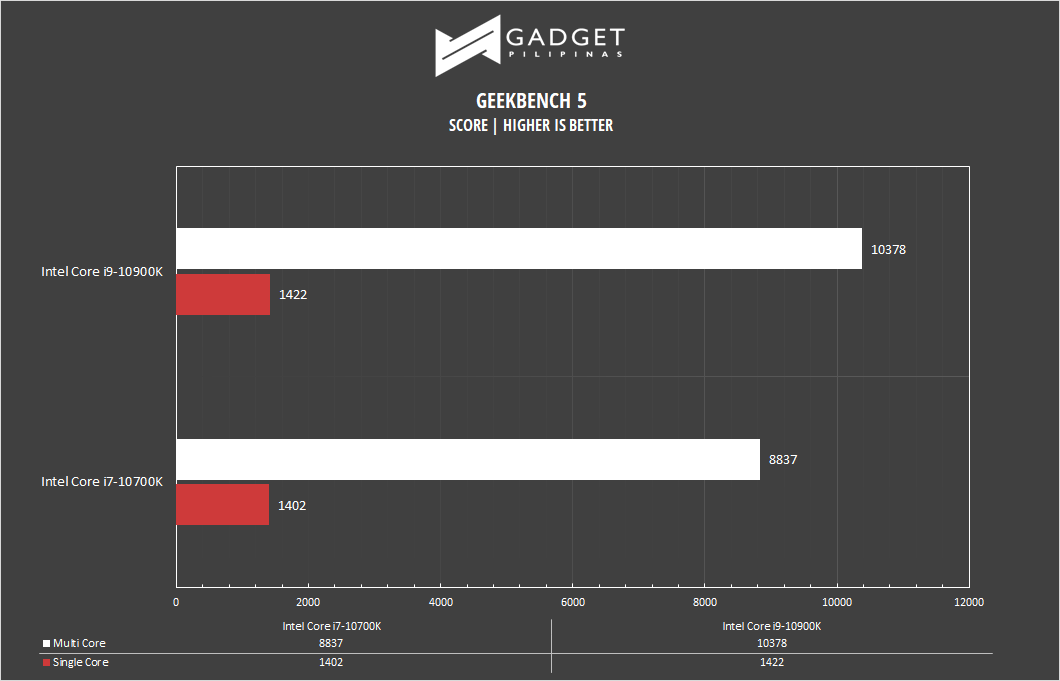 Geekbench is a multi-platform benchmark that’s used to gauge CPU performance and compare them across Windows, Mac, and Mobile. Geekbench 5 is the latest version and doesn’t rely on memory as much compared to the previous Geekbench 4, making it a great tool to measure both single-core and multi-core CPU performance.
Geekbench is a multi-platform benchmark that’s used to gauge CPU performance and compare them across Windows, Mac, and Mobile. Geekbench 5 is the latest version and doesn’t rely on memory as much compared to the previous Geekbench 4, making it a great tool to measure both single-core and multi-core CPU performance.
CINEBENCH R20
 Maxon’s Cinebench benchmark is one of the most iconic benchmark applications used by reviewers and enthusiasts. The latest Cinebench R20 uses the latest rendering architectures, including Intel’s Embree ray tracing technology and other advanced features from AMD and Intel that allows users to render the same scene on the same hard. Cinebench R20 uses a larger and more complex testing scene than Cinebench R20 by about 8x computational power and requires 4x the memory.
Maxon’s Cinebench benchmark is one of the most iconic benchmark applications used by reviewers and enthusiasts. The latest Cinebench R20 uses the latest rendering architectures, including Intel’s Embree ray tracing technology and other advanced features from AMD and Intel that allows users to render the same scene on the same hard. Cinebench R20 uses a larger and more complex testing scene than Cinebench R20 by about 8x computational power and requires 4x the memory.
V-RAY
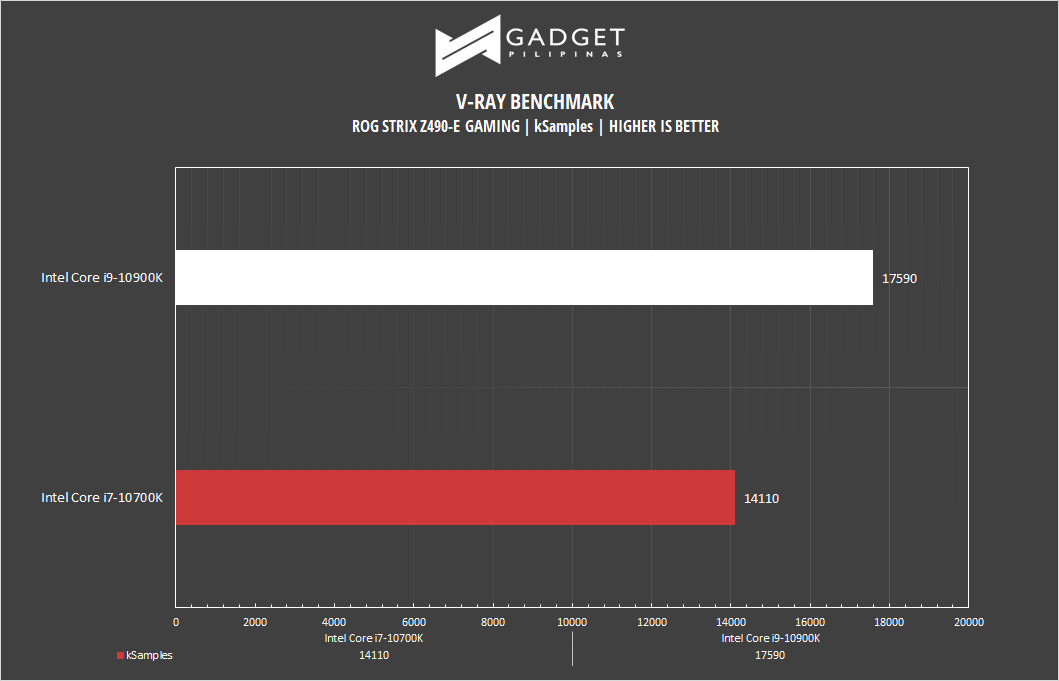 V-Ray Benchmark is a stand-alone version V-Ray developed by Chaos Group. It is designed to test the CPU and GPU by rendering sample scenes at a fixed amount of time. V-Ray is a plug-in mostly utilized by 3D computer graphics software applications mainly for industrial design, product design, architecture, film, and video game production. V-Ray is not limited to 64-threads as it supports multi and mega threading.
V-Ray Benchmark is a stand-alone version V-Ray developed by Chaos Group. It is designed to test the CPU and GPU by rendering sample scenes at a fixed amount of time. V-Ray is a plug-in mostly utilized by 3D computer graphics software applications mainly for industrial design, product design, architecture, film, and video game production. V-Ray is not limited to 64-threads as it supports multi and mega threading.
HWBOT x265
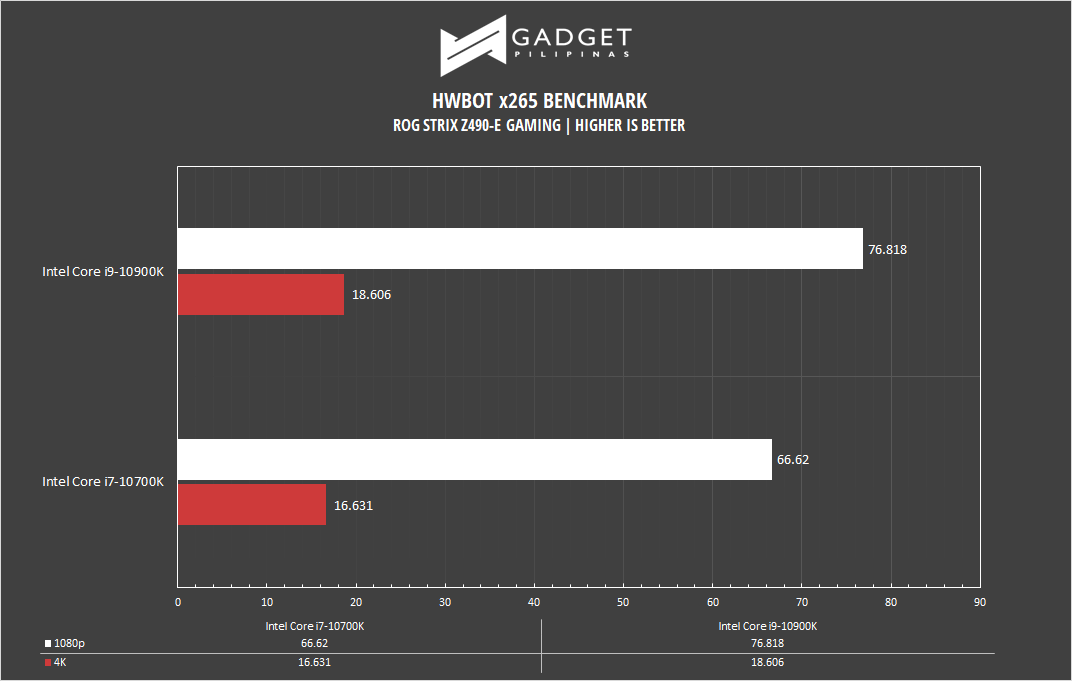 HWBOT x265, developed by Czech overclocker Havli, is a multi-threaded application that takes advantage of modern CPU instruction sets with support for older CPUs. HWBOT x265 benchmark uses the x265/HEVC encoder that renders a video in 1080p or 4K resolution.
HWBOT x265, developed by Czech overclocker Havli, is a multi-threaded application that takes advantage of modern CPU instruction sets with support for older CPUs. HWBOT x265 benchmark uses the x265/HEVC encoder that renders a video in 1080p or 4K resolution.
HANDBRAKE
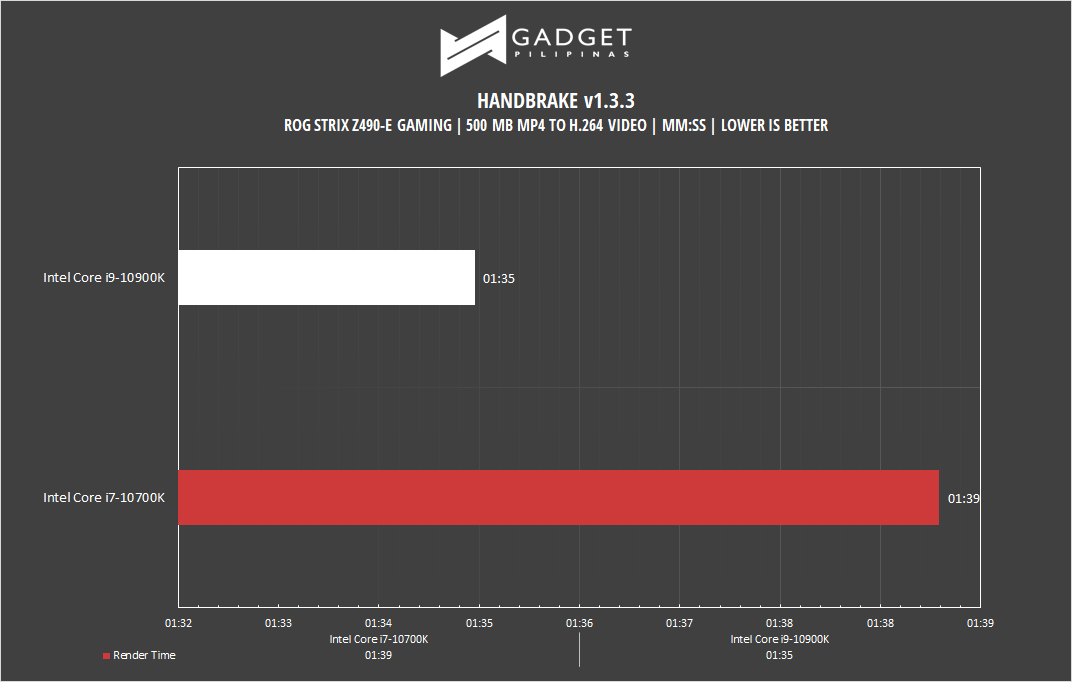 Handbrake is a top-rated open-source video conversion software that is used by professionals, enthusiasts, and even reviewers as a reference point mainly because of its wide variety of media codecs. The rise of streaming and blogging makes video content, both encoding, and transcoding necessary for these people, regardless if they’re seasoned professionals or just starting out. Handbrake also takes advantage of AVX-512 and OpenCL to accelerate certain types of media codecs. Our Handbrake benchmark converts a 500MB MP4 video to H.264 to measure the processor’s performance.
Handbrake is a top-rated open-source video conversion software that is used by professionals, enthusiasts, and even reviewers as a reference point mainly because of its wide variety of media codecs. The rise of streaming and blogging makes video content, both encoding, and transcoding necessary for these people, regardless if they’re seasoned professionals or just starting out. Handbrake also takes advantage of AVX-512 and OpenCL to accelerate certain types of media codecs. Our Handbrake benchmark converts a 500MB MP4 video to H.264 to measure the processor’s performance.
BLENDER
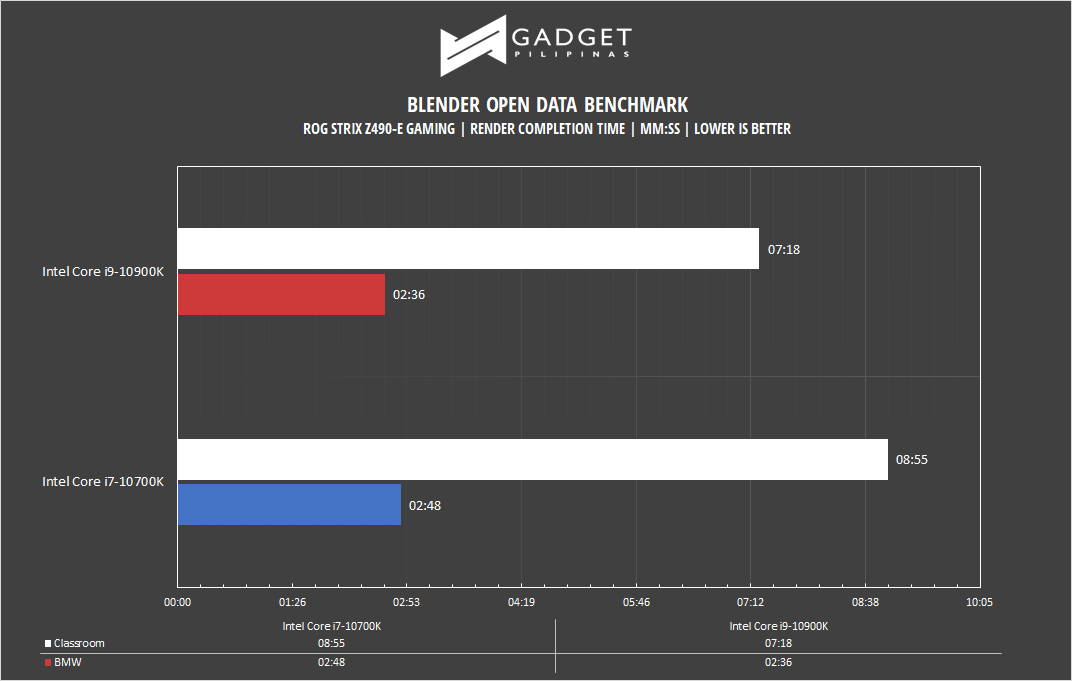 Blender is a widely used, free, opensource 3D creation suite. It supports the whole 3D pipeline process from modeling, rigging, animation, simulation, rendering, and even motion tracking. Blender has become a standard for CPU benchmarks with the BMW27 and Classroom scene most used. This prompted the company to release Blender Open Data Benchmark in 2018, a benchmark-specific version which allows users to run a preset benchmark and share the results online similar to 3D Mark.
Blender is a widely used, free, opensource 3D creation suite. It supports the whole 3D pipeline process from modeling, rigging, animation, simulation, rendering, and even motion tracking. Blender has become a standard for CPU benchmarks with the BMW27 and Classroom scene most used. This prompted the company to release Blender Open Data Benchmark in 2018, a benchmark-specific version which allows users to run a preset benchmark and share the results online similar to 3D Mark.
CORONA RENDERER
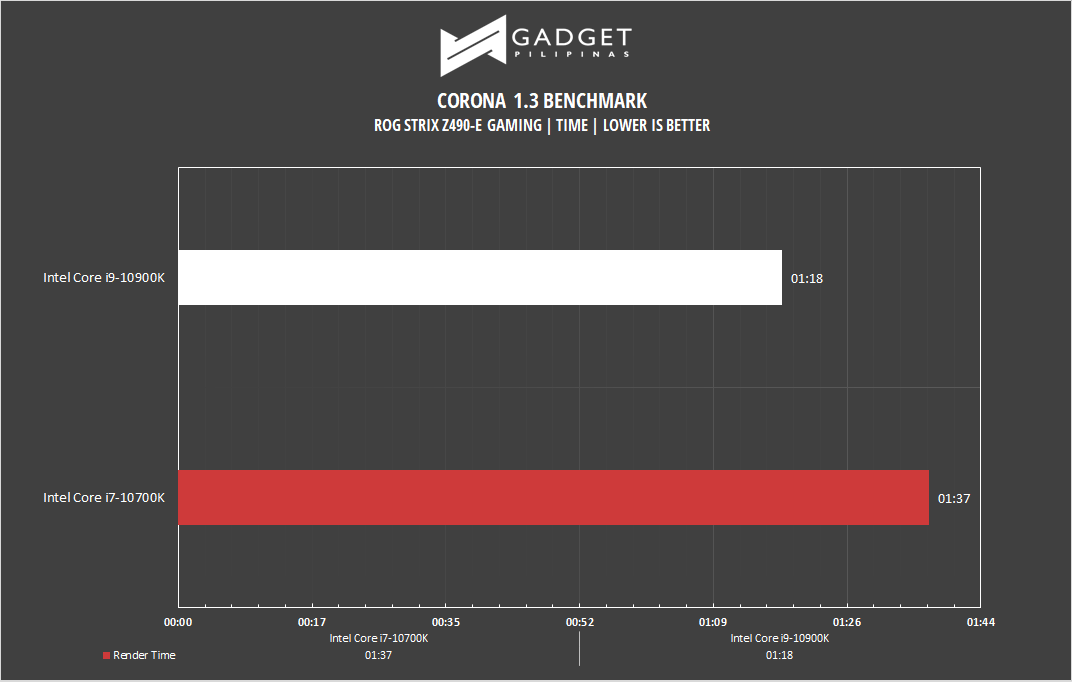 Corona Renderer is an unbiased photorealistic render available for Autodesk 3Ds Max, Maxon Cinema 4D, and as a stand-alone application. Its popularity, similar to Blender, led Chaos Group to develop a benchmark version of the app which runs using Corona Renderer 1.3. Workstation systems, especially CPUs, can utilize Corona Benchmark as up to 72 threads can be used in the benchmark, making it very suitable for CPUs with various price segments.
Corona Renderer is an unbiased photorealistic render available for Autodesk 3Ds Max, Maxon Cinema 4D, and as a stand-alone application. Its popularity, similar to Blender, led Chaos Group to develop a benchmark version of the app which runs using Corona Renderer 1.3. Workstation systems, especially CPUs, can utilize Corona Benchmark as up to 72 threads can be used in the benchmark, making it very suitable for CPUs with various price segments.
3DMARK
- ASUS ROG Strix Z490 E Gaming Motherboard Review 3DMark Firestrike Benchmark
- ASUS ROG Strix Z490 E Gaming Motherboard Review 3DMark Firestrike Benchmark
- ASUS ROG Strix Z490 E Gaming Motherboard Review 3DMark TIMESPY Benchmark
- ASUS ROG Strix Z490 E Gaming Motherboard Review 3DMark TIMESPY Benchmark
3DMark is the go-to benchmark for gamers because of the ability to share and compare results online. We used Time Spy DirectX 12 benchmark and Fire Strike DirectX 11 benchmark to gauge the CPU’s performance using different APIs.
Overclocking and VRM Temps
Despite the incredible VRMs on the ROG Strix Z490-E Gaming, our luck in silicon lottery only allowed us to push a 5.1Ghz all-core overclock on the Intel Core i9-10900k. To achieve the 5.1Ghz OC, we needed to push a voltage of 1.4 volts which is considerably high for a daily-use overclock. Our Intel Core i9-10900k processor was bought on launch day so we didn’t expect a high overclock.
We were very impressed to see the results of our combined Prime95 + AIDA64 stress test on the ROG Strix Z490-E Gaming Motherboard. Both the i7 10700k and the i9 10900K were tested to see how the Z490-E would handle the 125w and 225w TDPs. The ROG Strix Z490-E Gaming easily handles both processors, even the overclocked i9 10900k we only recorded a maximum temp of 56.5°c with the backside of the PCB measuring 50.1°c.
CONCLUSION
The ROG Strix Z490-E Gaming motherboard is definitely a premium motherboard considering its feature set as well as its Php 14,540 price tag. Reiterating what we said in our first impressions article, the ROG Z490-E Gaming provides the best possible performance and build quality for its price range of under Php 15,000. It sports your ROG-exclusive, over the top features, such as AI implementation, supremeFX audio, a robust port selection, not to mention the signature stylish ROG cyber-text design that makes it look like you’re stepping into the ROG Maximus territory. Whether you’re putting in an unlocked i5, i7, or i9 processor, the ROG Strix Z490-E would easily unlock the processor’s potential with the only bottleneck being your cooler or luck in the silicon lottery.
The ASUS ROG Strix Z490-E Gaming motherboard is an outstanding motherboard that prioritizes achieving top-tier performance and build quality in a mid-range Z490 segment that simply other motherboard vendors couldn’t compete. Unless you’re looking at the extra connectivity or pre-built liquid cooling support on higher-end motherboards such as the Maximus series, then there’s no reason to look further other than the ASUS ROG Strix Z490-E Gaming. That said, the ROG Strix Z490-E earns the spot as our motherboard of choice on our Intel test bench for future reviews, next to its AM4 counterpart, the ROG Strix X570-E Gaming.
Grant is a Financial Management graduate from UST. His passion for gadgets and tech crossed him over in the industry where he could apply his knowledge as an enthusiast and in-depth analytic skills as a Finance Major. His passion allows him to earn at the same time help Gadget Pilipinas' readers in making smart, value-based decisions and purchases with his reviews and guides.

